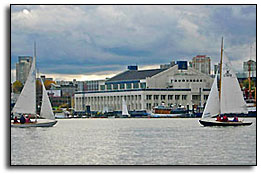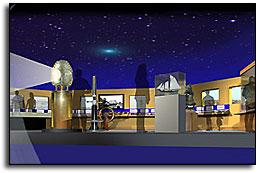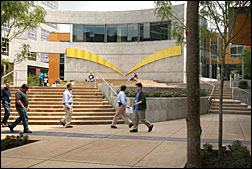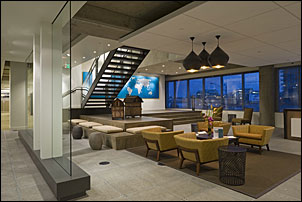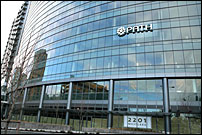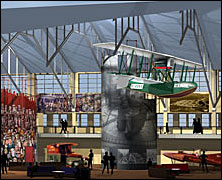Weaving a dream in Seattle’s Cascade Neighborhood
/ They say a picture’s worth a thousand words.
They say a picture’s worth a thousand words.
Just east of the bustle of Seattle’s rapidly developing South Lake Union neighborhood, a newly complete civic mural reminds visitors of how interpersonal connections, personal surroundings and an awareness of the environment can influence a community, and balance change.
“Here, everything is fast paced,” said Capitol Hill artist Adream de Valdivia who was commissioned for the 100-foot-long mural symbolically knitting together the upper façade of neighborhood’s Y at Cascade People’s Center through a Community Project grant in cooperation with the South Lake Union Community Council. The project was part of Seattle Mayor Ed Murray’s Find It, Fix It community walking tour of Cascade on July 11.
“It’s so easy to lose sight of people connecting,” said the artist, gesturing to a handful of construction cranes standing sentry over the global technology and health sciences research hub emerging just to the west.
“This is about being in the here and now,” he said. “To be more sensitive to what we are seeing.”
For de Valdivia, a principled 30-year-old who grew up along the Columbia River in the Tri-Cities communities of Richland and Pasco before coming to Seattle to study at Cornish College of the Arts, his work with carefully outlined geometric shapes and iconic environmental imagery does as much to beautify the building and neighboring Cascade Playground as it does to knit together a diverse, residential community.
The mural "A Dream for Cascade" is inspired by the aboriginal dream art and traditional Spanish tapestries knitted by his grandmother Flora Arteaga.
“She is the big dreamer,” said de Valdivia, a first-generation American whose first name, pronounced AHH-dree-uhm, comes from a family belief that ‘life is a dream’.
“It was her dream to offer her kids more opportunities,” he said.
And de Valdivia’s dream too.
While woven tapestry as an art form dates back to third century China depicting symbolic emblems, mottoes and coats of arms of nobility, the father of a two-year-old is among a contemporary generation of artists applying personal expression, styles and subject matter either through weft-faced tapestry or other mediums to engage neighbors.
In Cascade, de Valdivia has enlivened the side of a once-bleak building with spray paint from a local hardware store, helping to tell a story and knit together one of Seattle’s oldest neighborhoods.
“All the details. It’s a lot of problem solving,” said de Valdivia, climbing down a few rungs on an aluminum ladder to replace a can of lime-green industrial spray paint, one of some 27 individual cans used craft the fresco -- easiestly the largest in Cascade.
With the look of well-thought-out street graffiti with Hispanic overtures, his completed works have spanned genres and generations with depictions of historical figures such as Albert Einstein and Ben Franklin to the likeness of Pearl Jam’s Eddie Vedder at a favorite neighborhood coffee stop, Café Torino.
An award winning artist who has over 1,000 paintings and sculptures to his credit including a mural project honoring U.S. veterans that he has underway in Olympia, De Valdivia’s works espouse the energy of a city – street art with life-changing moments.
Both his art – and inspiration to paint, deliver a message.
During a high school field trip to the Seattle Art Museum, de Valdivia was taken aback by the work of an early 20th century Mexican surrealist, Frida Kahlo. Her work spoke to him.
Remembered for her self-portraits, pain and passion, and bold, vibrant colors, de Valdivia explained the intensity – and hope that he could see in Kahlo’s art.
And also in the historic, working-class Cascade community, stressed with the aches of a growing city.
“I learned that anyone, especially Frida as the power to turn pain into passion,” he said. “It was her view. How she saw everything taught me to let go and express myself through painting.”
“Like Cascade and its people. It reminds me to listen more and stay connected,” de Valdivia said.
“And now I’m a part of it,” he said. “It’s the beginning of what can be done to make people feel at home.”
If You Go
The Cascade Tapestry is located on the southern façade of the Y at Cascade People's Center in Seattle’s Cascade Playground. 309 Pontius Ave. North, Seattle, WA 98109.
Paintings by Adream Pedro de Valdivia can be seen at Adream Studios, 815 East Pine Street, Seattle, WA 98101, Monday – Friday from 9 a.m. – 5 p.m. Or follow Adream Studios on Facebook at AdreamStudios or Instagram at Adream300.
~ The author Mike McQuaid is the president of the South Lake Union Community Council


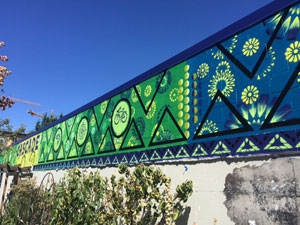

 Earlier this month Seattle City Councilmember Sally Bagshaw attended a meeting of the South Lake Union Community Council, a very well organized and committed group of people who work and live in the rapidly growing South Lake Union community.
Earlier this month Seattle City Councilmember Sally Bagshaw attended a meeting of the South Lake Union Community Council, a very well organized and committed group of people who work and live in the rapidly growing South Lake Union community.